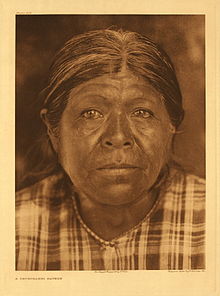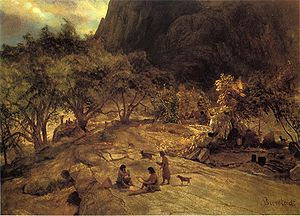- Yokuts people
-
Yokuts Total population 2,600[1] Regions with significant populations  United States (
United States ( California)
California)Languages Religion traditional tribal religion, Christianity, Kuksu religion,[3] previously Ghost Dance[4]
Related ethnic groups The Yokuts (previously known as Mariposans[5]) are an ethnic group of Native Americans native to central California. Prior to European contact, the Yokuts consisted of up to 60 separate tribes speaking the same language.
Some of their descendants prefer to refer to themselves by their respective tribal names and reject the name Yokuts with the claim that it is an exonym invented by English speaking settlers and historians. "Yokuts" means "People." Conventional sub-groupings include the Foothill Yokuts, Northern Valley Yokuts, and Southern Valley Yokuts.[6]
Contents
Territory
Yokuts tribes populated the San Joaquin Valley,[2] from the Sacramento-San Joaquin River Delta ("the delta") south to Bakersfield and also the adjacent foothills of the Sierra Nevada mountain range, which lies to the east. In the northern half of the Yokuts region, there were some tribes inhabiting the foothills of the Coast Range, which lies to the west. There is evidence of Yokuts also inhabiting the Carrizo Plain and creating rock art in the Painted Rock area.
Population
Estimates for the pre-contact populations of most native groups in California have varied substantially (See Population of Native California). Alfred L. Kroeber in 1925[7] put the 1770 population of the Yokut at 18,000. Several subsequent investigators suggested that the total should be substantially higher.[8] Robert F. Heizer and Albert B. Elsasser 1980[9] suggested that the Yokut had numbered about 70,000. They had one of the highest regional population densities in pre-contact North America.[2]
The numbers of Foothill Yokut were reduced by around 93% between 1850 and 1900. A few Valley Yokut remain, the most prominent tribe among them being the Tachi. Kroeber estimated the population of the Yokut in 1910 as 600.
Today there are about 2000 enrolled Yokut in the federally recognized tribe, and 600 more Yokut belonging to unrecognized tribes.[2]
Language
The Yokutsan language is a member of the Penutian language family.[2]
Tribes and villages
Yokut tribes
Contemporary communities
- Santa Rosa Rancheria (Tachi)
- Picayune Rancheria of Chukchansi Indians (Chukchansi)
- Table Mountain Rancheria (Chukchansi)
- Tule River Indian Tribe of the Tule River Reservation[10]
- Tuolumne Rancheria[2]
The contemporary Wukchumni and Choinumni communities do not yet have federal recognition.[10]
Trading routes
Yokuts are known to have engaged in trading with other California tribes of Native Americans including coastal peoples such as the Chumash of the Central California coast, with whom they are thought to have traded plant and animal products.[11]
Notable Yokuts
See also
Notes
- ^ California Indians and Their Reservations: P. San Diego State University Library and Information Access. 2009 (retrieved 29 June 2010)
- ^ a b c d e f g California Indians and Their Reservations: Y. San Diego State University Library and Information Access. 2009 (retrieved 29 June 2010)
- ^ Pritzker, 157
- ^ Pritzker, 157
- ^ Powell, 1891:90-91.
- ^ Pritzker, 146
- ^ Kroeber 1925:883.
- ^ Baumhoff 1963; Cook 1955; Wallace 1978.
- ^ Heizer and Elsasser 1980:16.
- ^ a b Pritzker, 159
- ^ Hogan, 2008
References
- Kroeber, A. L. 1910. On the Evidences of Occupation of Certain Regions by the Miwok Tribes, University of California Press, Berkeley, Vol. 6 No. 3 p. 370 [1]
- Kroeber, A. L. 1925. Handbook of the Indians of California. Bureau of American Ethnology Bulletin No. 78. Washington, D.C.
- Pritzker, Barry M. A Native American Encyclopedia: History, Culture, and Peoples. Oxford: Oxford University Press, 2000. ISBN 978-0195138771.
External links
- Tachi Yokut Tribal website
- Info About Yokuts, by the Minnesota State University
- Culture and History, by Native Languages of the Americas
Further reading
- Baumhoff, Martin A. 1963."Ecological Determinants of Aboriginal California Populations". University of California Publications in American Archaeology and Ethnology 49:155-236.
- Cook, Sherburne F. 1955. "The Aboriginal Population of the San Joaquin Valley, California". Anthropological Records 16:31-80. University of California, Berkeley.
- Cummins, Marjorie W. (1978). The Tache-Yokuts, Indians of the San Joaquin Valley. Pioneer Publishing Company. ISBN 0-914330-24-1.
- Heizer, Robert F., and Albert B. Elsasser. 1980. The Natural World of the California Indians. University of California Press, Berkeley.
- Powell, John Wesley Powell 1891. Indian Linguistic Families Of America, North Of Mexico, Government Printing Office, Washington, pages 90-91.[2]
- Wallace, William J. 1978. "Southern Valley Yokuts". In California, edited by Robert F. Heizer, pp. 448-469. Handbook of North American Indians, William C. Sturtevant, general editor, vol. 8. Smithsonian Institution, Washington, D.C.
- Webb, Frederick 1910. Tachi and Tammukan, in Handbook of American Indians North of Mexico, Government Printing Office.[3]
Population groups of Native California Achomawi · Atsugewi · Bay Miwok · Cahuilla · Chemehuevi · Chimariko · Chumash · Coast Miwok · Cupeño · Eel River Athapaskans (Lassik, Nongatl, Sinkyone, Wailaki) · Esselen · Gabrielino (Tongva) · Halchidhoma · Hupa (Chilula, Whilkut) · Juaneño (Acjachemen) · Karuk · Kato · Kawaiisu · Kitanemuk · Kumeyaay (Diegueño, Ipai, Tipai) · Lake Miwok · Luiseño · Maidu · Mattole (Bear River) · Modoc (Klamath) · Mohave · Mono (Monache, Owens Valley Paiute) · Nomlaki · Northern Paiute · Ohlone (Costanoan) · Patwin · Pomo · Quechan (Yuma) · Salinan · Serrano · Shasta (Konomihu, Okwanuchu) · Tataviam · Timbisha · Tolowa · Tübatulabal · Valley and Sierra Miwok · Wappo · Washoe · Wintu · Wiyot · Yana · Yokuts · Yuki · Yurok
Categories:- Yokuts
- California Mission Indians
- Native American tribes in California
- Native American history of California
- History of the San Joaquin Valley Area
- History of the Sierra Nevada (U.S.)
Wikimedia Foundation. 2010.


